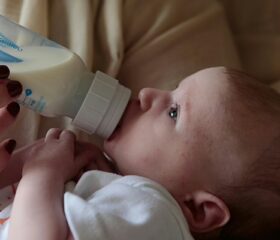Clogged Milk Ducts: Causes, Symptoms, and How to Treat Them
Breastfeeding is a wonderful way to connect with your baby, but that doesn’t mean it’s always smooth sailing. One common challenge many breastfeeding moms encounter is getting clogged milk ducts.

If you’re breastfeeding and notice a sore, lumpy spot on your breast, chances are a clogged or plugged milk duct is to blame. While they usually aren’t serious, these can be painful and frustrating.
Read on for a complete overview of clogged milk ducts, including their causes, symptoms, treatment options, and how to prevent them in the first place.
What is a clogged milk duct?
Milk ducts are like a network of tiny straws in your breasts that carry milk from your glands to your nipple. When milk becomes backed up in one or more of these ducts, it causes a blockage.
A clogged milk duct may leave you with a tender lump in your breast, often accompanied by redness and discomfort.
What causes clogged milk ducts?
There are several causes for clogged milk ducts, including:
- Incomplete emptying: Milk ducts can get clogged when you aren’t fully emptying your breasts. Skipping feedings or pumping sessions increases the chances of this happening. 1
- Rapid weaning: For the same reason, you may also get clogged milk ducts when you abruptly stop or cut down on breastfeeding. If you’re weaning your baby, do it gradually.
- Too much pressure: External pressure can compress your milk ducts, causing clogs. Tight bras or clothing are the biggest offenders here. 1
- Improper latching: If your baby isn’t latching or suckling properly, your breasts won’t get completely drained. 2
- Stress and fatigue: Too much stress could decrease your oxytocin levels, potentially leading to less milk let down and increasing your chances of clogged milk ducts. 3 4
- Oversupply: Producing more milk than your baby can drink means your milk ducts are more likely to get clogged. 5 This can happen for several reasons, including pumping too frequently.
Don’t confuse clogged milk ducts with similar issues, like clogged Montgomery glands (the oil-producing glands on your areolas that become more prominent during pregnancy). While these glands can sometimes get blocked, this doesn’t happen due to breastfeeding, but usually as a result of overapplying creams or ointments (or simply having overactive sebaceous glands).
What are the symptoms of clogged milk ducts?
You’ll probably be able to tell when you have clogged milk ducts—they hurt!
The most noticeable symptom is the appearance of one or more small, firm, and tender lumps in your breasts. Each will feel like a pea or marble under the skin, and the area around it will be sore. The discomfort may either be constant or only occur during breastfeeding or pumping.
Other symptoms may include: 1
- Redness: The skin over the lump may appear reddish or inflamed, and may also feel warm.
- Milk blisters (blebs): You might see small white or yellowish blisters on your nipple opening. 6
- Less milk flow: You may notice lower milk production from the affected breast. Your baby might also be fussier when nursing from the affected side.
What are the differences between clogged ducts and mastitis?
Clogged ducts can sometimes lead to mastitis—a breast infection that requires medical treatment. That isn’t always the case, and clogged ducts and mastitis are considered different conditions with distinct symptoms.
Refer to the table below to compare the two: 7
Clogged milk ducts vs. mastitis
| Symptom | Clogged milk duct | Mastitis |
|---|---|---|
| Lump | Smaller and more, localized | May be multiple lumps, or a larger area of hardness |
| Pain | Localized pain, mild to moderate | More intense pain, tenderness, and a burning sensation throughout the breast |
| Redness | Localized redness around the lump | Redness may spread over a larger area of the breast |
| Warmth | Localized warmth | Breast will feel hot to the touch |
| Systemic symptoms | None (you’ll feel well, apart from the lump) | Flu-like symptoms: fever (100.4°F or higher), chills, body aches, and fatigue |
| Nipple discharge | Decreased milk flow | May have pus or blood in the milk |
If you suspect you have mastitis, call your OB immediately, as you may need antibiotics to stop the infection. However, even if you have mastitis, continue to breastfeed and pump milk as normal. This will help clear the infection (and keep your baby well-fed).
How to treat clogged milk ducts
Sometimes, clogged milk ducts resolve on their own over time. If they don’t, the good news is that you can usually treat them at home with simple, natural remedies.
- Continue breastfeeding and pumping: As painful as it might be, don’t stop breastfeeding or pumping. Start with the affected breast first, and nurse or pump every 2 hours. Your baby’s suckling may actually help dislodge the blockage. Make sure you empty your first (clogged) breast before switching to the second. 5
- Massage: Gently massage the affected area of your breast while breastfeeding or pumping. Use small, circular motions, moving from the outer edges of the breast toward the nipple. For added relief, you can also perform this massage while you’re in a warm shower or bath.
- Lymphatic drainage: This is a particular type of massage where you lightly but firmly place your fingertips on your skin in your armpit and upper chest, moving upwards of your chest and over your collarbone. 8
- Warm compresses: Apply a warm, clean compress or washcloth to your affected breast for at least 10 minutes before each feeding or pumping session. 1 If you develop a nipple bleb (a blister), try soaking the nipple in warm water or gently exfoliating it with a clean, damp cloth. You can also try ice packs if heat doesn’t help. 9
- Change feeding positions: Try out different feeding positions where your baby’s chin points toward the clogged area. It sounds counterintuitive, but this will align his suction with the affected duct.
- Loose clothing: Wear loose-fitting clothes and avoid tight or restrictive underwear, such as underwire bras, which can restrict your milk flow.
- Electric toothbrush: Some mothers have found relief by gently applying the back (not the bristles) of an electric toothbrush to the clogged area. 2 The vibrations may help to loosen the blockage. Use caution and avoid applying too much pressure.
If your pain isn’t easing up with any of these methods, you can take over-the-counter pain relievers like ibuprofen or acetaminophen—but ask your OB first before doing so. 10
How to prevent clogged milk ducts
No mom wants breastfeeding to become a burden. You can lower your chances of developing milk ducts with a few simple preventative measures:
Choose the right pumps
Regardless of whether you’re using a standard or wearable breast pump, ensure that your flanges are the correct size for your nipples. Using the wrong flanges might prevent you from emptying your breasts completely. After pumping, your breasts should feel soft. 1
Drink and eat well
Drinking lots of water or herbal teas supports better milk flow. Aim for roughly 12–16 cups of water per day. 11
As for your breastfeeding diet, limiting saturated fats and cutting back on salt could prevent clogged milk ducts, too. Some doctors also recommend taking lecithin supplements, although there isn’t quite enough data to verify whether this really works. 12 13 Talk with your doctor or a lactation consultant before taking supplements.
Make sure your baby latches properly
One of the best ways to avoid clogged milk ducts is to get your baby to latch properly. Not only will this ensure he gets as much milk from you as possible, you’ll be able to empty your breasts properly and avoid milk duct blockages.
Here are some simple tips to ensure a good latch:
- Make sure your baby’s feeding environment is calm and relaxing.
- Hold your little one (skin-to-skin is ideal), making sure his chest is resting against your body and his chin is touching your breast.
- Follow your baby’s signs to see if he is hungry. If he is, let him figure out how to suckle. Support him, but don’t force him or help him to latch.
A good latch should feel comfortable and will not hurt or pinch you. You’ll also see little to nothing of your areola (the darker area around your nipple).
When to seek professional help
While you can manage most incidences of clogged milk ducts at home, don’t hesitate to ask your doctor or lactation consultant for help. A lactation consultant is a professional who offers personalized guidance on breastfeeding techniques, latch issues, and other strategies to prevent and manage clogged milk ducts (and other breastfeeding woes).
Speak to your doctor if a clogged duct doesn’t improve after 24 to 48 hours of home treatment, especially if you also have: 1
- A fever of 100.4°F (38°C) or higher
- Flu-like symptoms, like chills, body aches, and fatigue
- Red streaks on your breast
- Pus or blood in your breast milk
- A history of recurrent mastitis
Some doctors may offer therapeutic ultrasound treatment for clogged milk ducts
You can talk to your doctor about therapeutic ultrasound treatment (TUS), which uses sound waves to remove milk duct blockages. However, this is a fairly experimental treatment—it might not be available in your area, and the evidence for it isn’t very strong, so keep your expectations modest. 8
Final thoughts
When you’re still getting to grips with this whole breastfeeding thing, a clogged milk duct is the last thing you need. Fortunately, although they’re a common complaint among breastfeeding moms, you can usually get a handle on them quickly. You’ll just have to soldier on and keep breastfeeding as much as your ravenous little bundle of joy demands.
Sticking to your feeding schedule and making yourself and your baby comfortable are often all it takes to clear those clogged milk ducts. With any luck, you’ll get to the point where you’re actually enjoying breastfeeding and can use this time to further strengthen that special bond between you and your baby.
Article Sources
- Arizona Department of Health Services. "Plugged Duct" Retrieved July 17, 2025.
- Touro Infirmary LCMC Health. "Go with the flow: how to treat a clogged milk duct" Retrieved July 17, 2025.
- University Hospitals. "Breastfeeding: Plugged Milk Ducts/Mastitis" Retrieved July 17, 2025.
- Frontiers in Endocrinology. "The Role of Oxytocin and the Effect of Stress During Childbirth: Neurobiological Basics and Implications for Mother and Child" Retrieved July 17, 2025.
- University of Kentucky. "Making Too Much Breast Milk (Oversupply)" Retrieved July 17, 2025.
- Cleveland Clinic. "Clogged Milk Duct" Retrieved July 17, 2025.
- Johns Hopkins Medicine. "Mastitis" Retrieved July 17, 2025.
- La Leche League International. "Mastitis and Sore Breasts" Retrieved July 17, 2025.
- University of Michigan Health. "Plugged Milk Ducts and Milk Blebs" Retrieved July 17, 2025.
- Johns Hopkins Medicine. "Plugged Milk Ducts" Retrieved July 17, 2025.
- Academy of Nutrition and Dietetics. "Nursing Your Baby — What You Eat and Drink Matters" Retrieved July 17, 2025.
- La Leche League USA. "Mastitis, Slowed Milk Flow, and Milk Blisters" Retrieved July 17, 2025.
- Drugs and Lactation Database. "Lecithin" Retrieved July 17, 2025.







